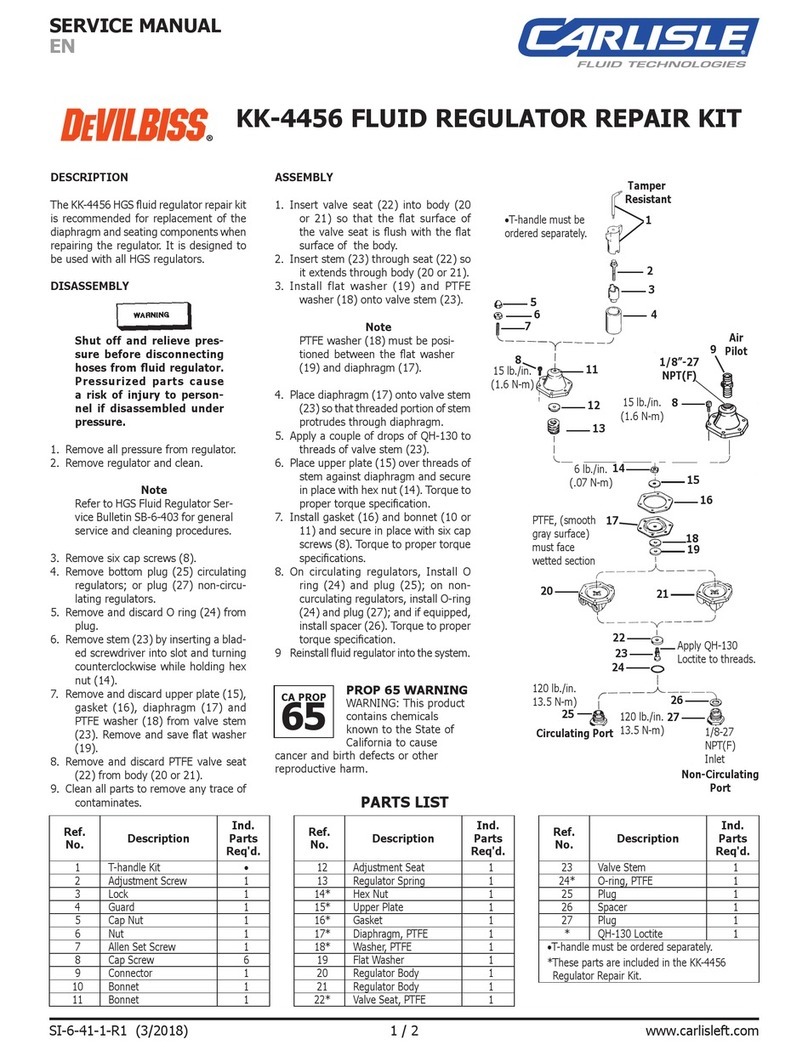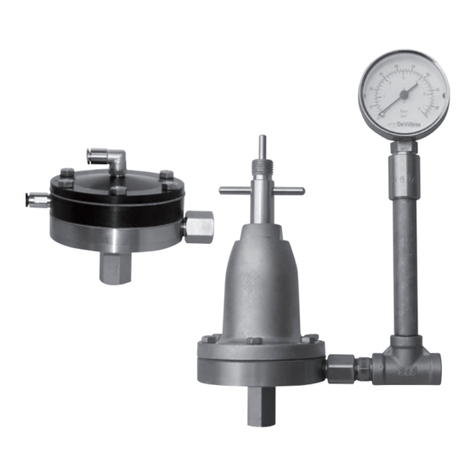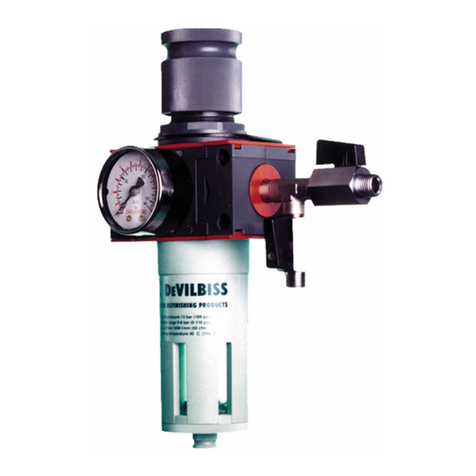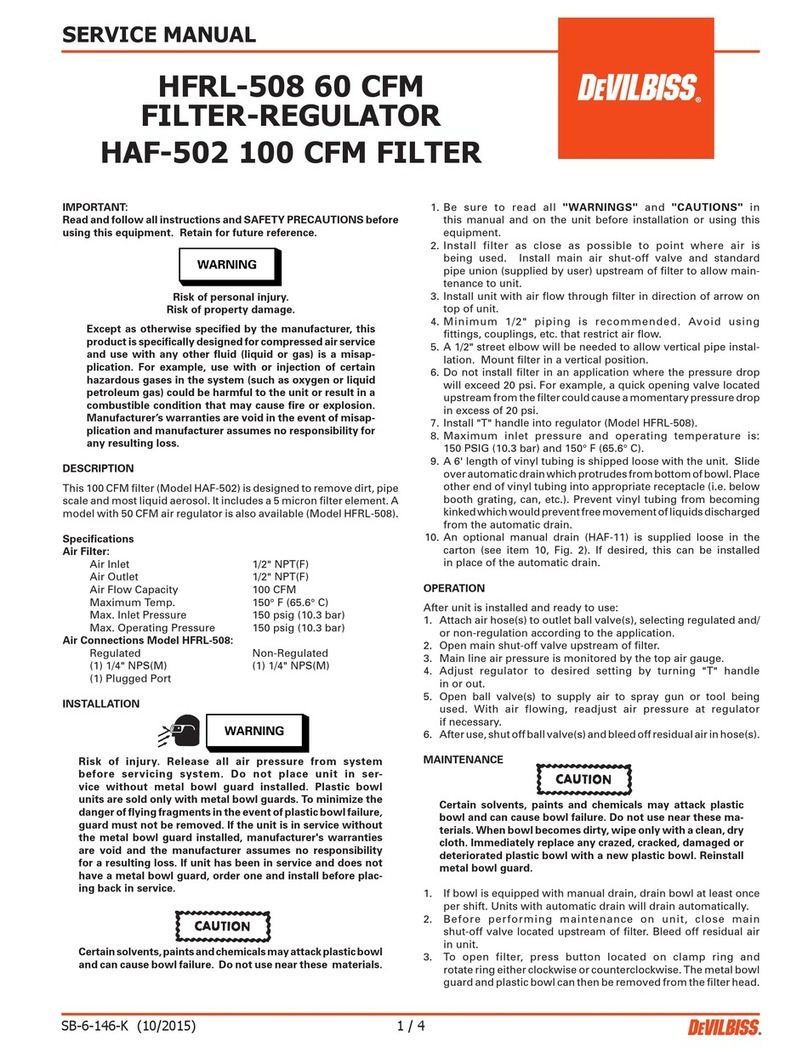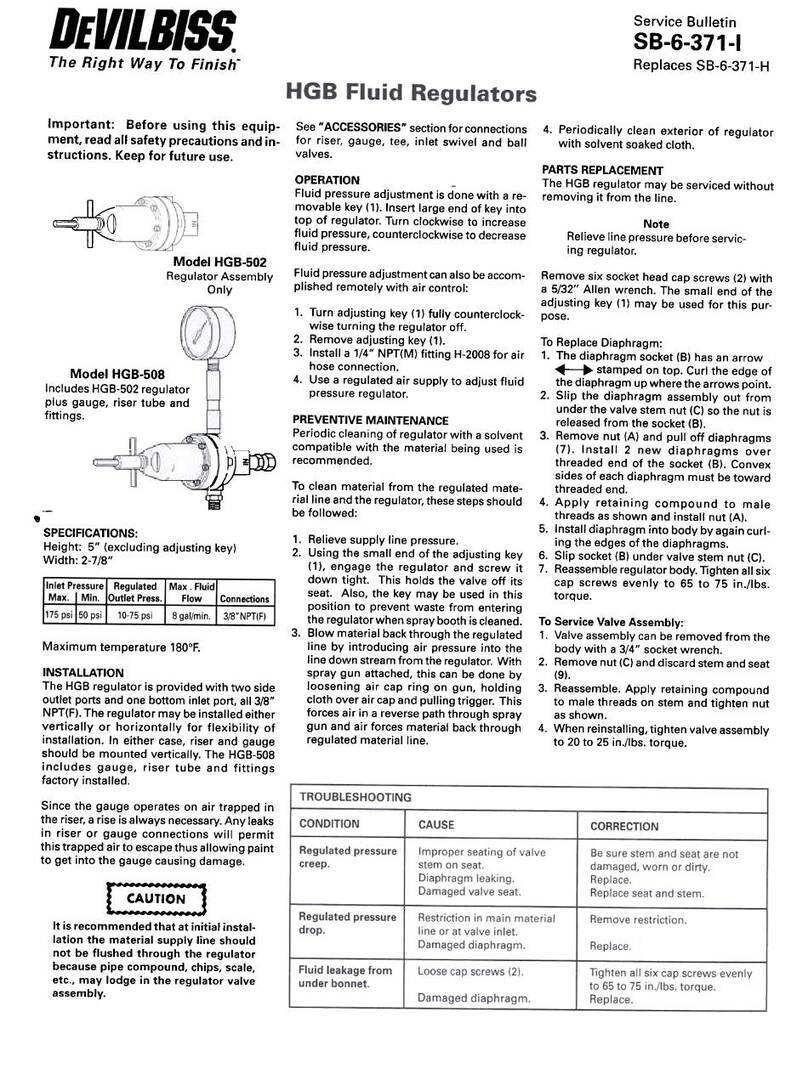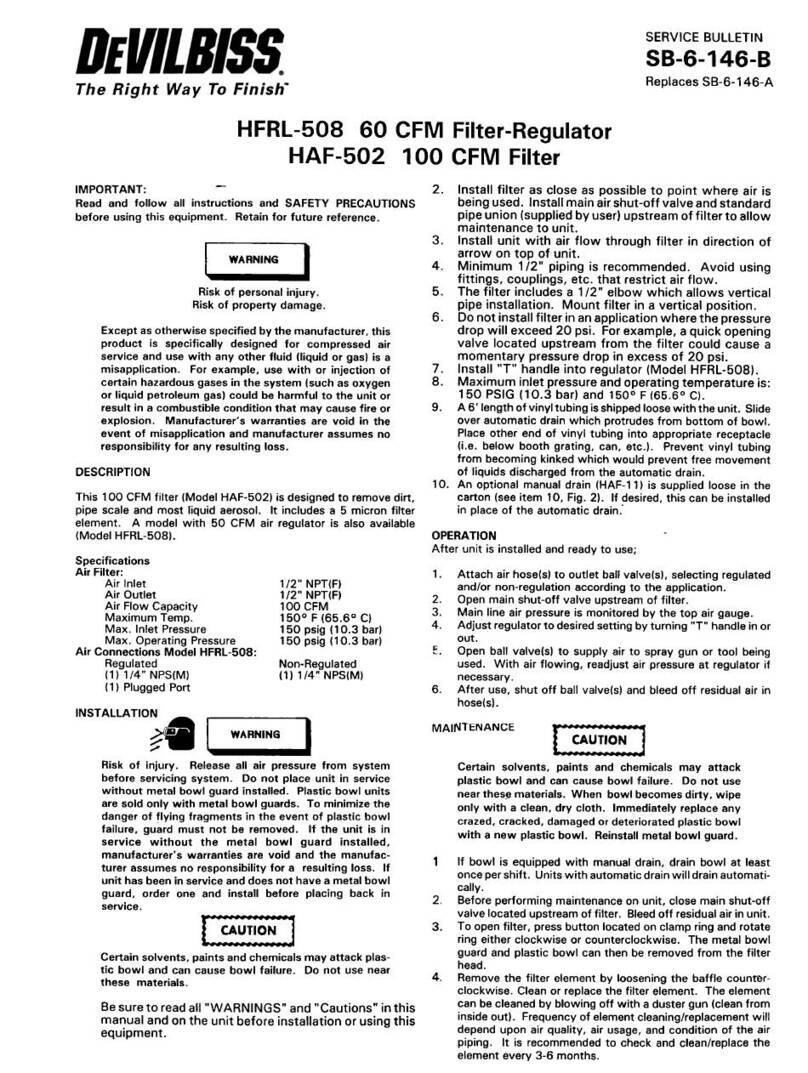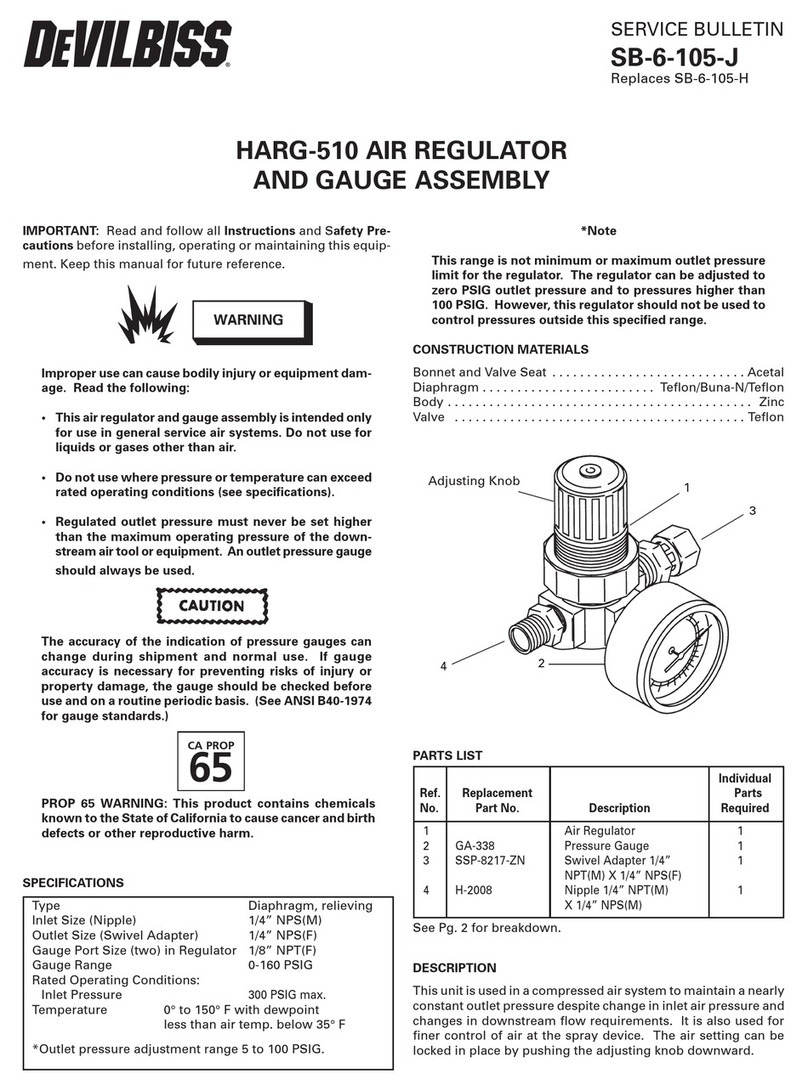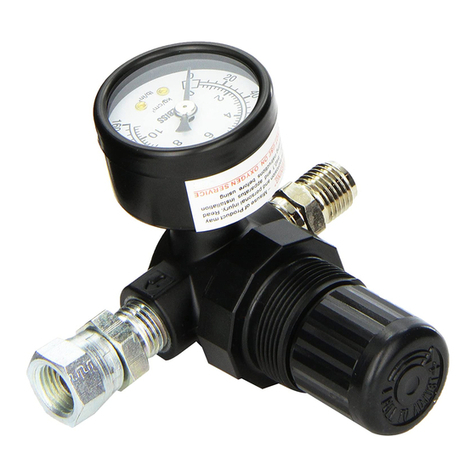
SB-6-403-J Page 3
TECHNICAL DATA
PSI (bar)
Fluid Inlet Pressure Min. 50 (3.5)
Max. 300 (20.7)
Regulated Fluid Min. 2 (0.14)
Pressure Range Max. 100 (6.9)
*Typical Flow Rates 150 to 2500 cc's/minute
oz's (grams)
Average Unit Weight
Models - Swivel 7.3 (210)
- Tamper Resist 7.9 (225)
- Standpipe 9.3 (265)
- Bayonet 9.7 (275)
Fluid oz's (ml)
Static Content
Models - Circulating 0.25 (7)
- Non-circulating 0.20 (5)
Wetted Parts 303 and 416 Stainless Steel,
Teflon ®
Models 17 models offered as standard
* Dependent upon viscocity and specific
gravity of material. Above information
based upon testing with mineral oil with
viscosity of 24 seconds #4 Ford, and
specific gravity of 0.84.
®Registered trademark of Dupont.
INSTALLATION
Risk of hazardous bursting or
equipment damage. Do not ex-
ceed 300 PSI (21 bar) maximum
fluid inlet pressure to regulator.
These regulators may be used
with most common coating and
finishing materials. However,
they are not designed for use
with highly abrasive materials.
If used with abrasive materials,
frequent and thorough clean-
ing will be required, and replace-
ment of parts will be increased.
1 . Where possible, mount the HGS regu-
lator as shown below with the fluid
outlet facing up. This will prevent
trapped air from causing erratic op-
eration. Trapped air can result from
an "air push" during a color change
cycle, or entrapped air in the paint.
2. Connect fluid inlet supply hose.
Circulating Models
Connect the fluid supply hose to ei-
ther fluid inlet adapter (53 or 54).
Connect the return line to the other
adapter (53 or 54).
Non-Circulating Models
Connect the fluid supply hose to
inlet of plug (23 or 40).
3. Connect fluid outlet.
Bayonet Regulators
Attach the bayonet lock body (41) to
the bayonet quick disconnect stem at
the spray gun fluid inlet.
3/8" Swivel Regulators
Thread swivel nut (49) onto fluid inlet
of spray gun body.
Standpipe Regulators
Attach fluid supply hose from spray
gun to bulkhead fitting (52).
4. Connect air inlet.
Air Pilot Regulators
Attach regulated air supply to
connector (25).
OPERATION
Risk of hazardous bursting or
equipment damage. Do not ex-
ceed 300 PSI (21 bar) maximum
fluid inlet pressure to regulator.
Fluid pressure adjustment range is from
2 psi to 100 psi (0.1 bar to 6.9 bar).
Fluid pressure to regulator inlet is
300 psi (20.7 bar) maximum and 50 psi
(3.5 bar) minimum.
To Regulate Fluid Pressure on Manual
Adjust Models
1. Remove cap nut (1) and loosen lock
nut (2).
2. With a 3/32 inch hex key allen
wrench, adjust hex key allen set
screw (3) for desired pressure set-
ting. Turn set screw (3) clockwise to
increase and counterclockwise to
decrease pressure.
3. Retighten lock nut (2) after desired
pressure setting has been established.
Replace and tighten cap nut (1).
To Regulate Fluid Pressure on Tamper
Resistant Models
1. Using T-handle (4B), loosen lock (6).
2. Engage adjusting screw (5) with torx
key (4A) and turn adjusting screw
until desired pressure setting is
reached. Turn torx key clockwise to
increase pressure and counterclock-
wise to decrease pressure.
3. Using the torx key, hold adjusting
screw (5) from turning and tighten
lock (6) with the T-handle (4B).
To Regulate Fluid Pressure on Air Pilot
Models
Fluid pressure is controlled by means of
air pressure. To actuate fluid flow, a
minimum of 12-14 psi air pressure must
be applied to the bonnet.Attach one end
of regulated air line to connector (25)
and the other end of the air line to a
remote regulator. Increase air pressure
to increase fluid pressure, and decrease
air pressure to decrease fluid pressure.
Fluid pressure remains constant unless air
pilot regulator setting is altered.
PREVENTIVE MAINTENANCE
Cleaning
Total submersion of the fluid
regulator in solvent for clean-
ing purposes will shorten the
life expectancy of the dia-
phragm.
The frequency with which the fluid
regulator should be cleaned will be the
same as the rest of the system in which
it is being used.
Bayonet Models
When spray gun is removed from service
and fluid regulator is not going to be used
for a period of time, the bayonet end
should immediately be soaked in solvent.
Do not submerge the entire regulator.
This will avoid hardening of material
around the ball and seat which may cause
leakage when regulator is put back in
service. The soaking container should be
an approved closed container if hazard-
ous solvents are used.
Fluid outlet should
face upward.
